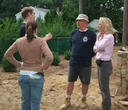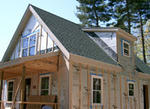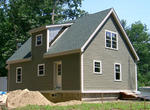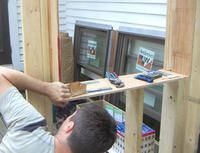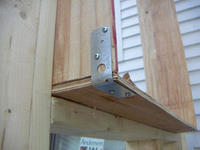Habitat for Humanity of Greater Lowell bought the land on which to build the Westford House from the town of Westford for $1. Habitat then partnered with Building Science Corporation, the community, local and national manufacturers, distributors and donors in an effort to create a comfortable, healthy, durable and energy efficient single family home.
Architects and engineers at BSC designed the plans and specifications for the Westford House with support from the Department of Energy’s Building America Program. The Westford House serves as a prototype for high performance, high R-value homes in cold climates. The systems engineering approach to the design of the Westford House led to a home that achieves a 44.1% energy reduction relative to the Building America benchmark. This significant energy reduction will save the homeowner approximately $1,259 per year in energy bills.
Habitat is committed to continuing to provide high performance homes to families in need. The non-profit recognizes not only the financial benefits but also the increased comfort, durability and healthy indoor environment that homes like the Westford House provide. In a celebration of community, Habitat officially turned the Westford House over to the homeowner at a Dedication Ceremony in early October of 2008.
Project Team: Habitat for Humanity of Greater Lowell, Building Science Corporation, Volunteers and Community Groups
Location: Westford, Massachusetts
Description: 1,340 ft2 3 bedroom, 2 bath, 11/2 story single family home
Completion Date: October 2008
Estimated Annual Energy Savings: $1,259 per year
Project Website: www.buildingscienceconsulting.com/portfolio/westford-habitat-house.aspx
Design
The goal of the Westford House prototype was to achieve a 40% whole house source energy reduction relative to the Building America benchmark. This was achieved by designing a high performance home with a high R-value enclosure, a right-sized mechanical system, energy efficient lighting, appliances, windows and doors. See First and Second Floor plans below. The high R-value enclosure was achieved by using 4” of rigid foam insulation on the interior of the basement walls, the exterior of the stud walls and on top of the roof rafters. Many details, particularly those involving the windows and doors, needed to be developed in order to ensure Habitat’s volunteers could successfully implement the critical water management and air barrier details. See the Design Challenge on page 5 for more information on installing windows and doors in 4” of foam.
The various mechanical and enclosure upgrade options were explored through a series of parametric annual loads studies. The studies show the percent improvement of each successive upgrade relative to the benchmark. The final study shown above outlines the mechanical and enclosure upgrades and indicates the Westford House, as designed, achieves a 44.1% source energy reduction relative to the benchmark, giving the home a HERS score of 50.

Builders Challenge Certificate
Enclosure Design
Roof Assembly: Rafter framed unvented attic with R-66 roof insulation: unfaced fiberglass batt insulation (R-40) in rafter bay with two 2” layers of foil-faced polyisocyanurate insulating sheathing (R-26) on top of roof sheathing (joints staggered and taped).

Unfaced fiberglass batt insulation in rafter bays
Wall Assembly: 2x6 walls at 24” o.c. with R-45 wall insulation: unfaced fiberglass batt insulation (R-19) in wall cavity with two 2” layers foil-faced polyisocyanurate insulating sheathing (R-26) on outside face of stud (joints staggered and taped).
Window Specifications: Harvey Vicon double hung with L-Fin adapter double pane vinyl Low-E Argon filled: U=0.33, SHGC=0.28.
Air Sealing: Maximum 2.5 in2 leakage area per 100 ft2 of enclosure area. Critical seal air sealing approach with primary air barrier maintained at interior gypsum walls and ceilings. Closed cell spray foam installed at first floor rim joist (with mineral wool insulation over top providing a thermal barrier). Low expanding foam used at second floor rim joist area (covered with fiberglass batt insulation). Adhesives and sealants used for air seal between framing members, between framing members and exterior insulating sheathing, around windows and doors, and at all mechanical and electrical penetrations through the enclosure.
Foundation Assembly: Conditioned basement with two 2” layers foil-faced polyisocyanurate insulating sheathing (R-26) applied to wood furring strips, 2” XPS (R-10) installed below concrete slab.
Mechanical Design
Heating and Cooling: 96% AFUE sealed combustion gas furnace with a MERV 13 filter installed in conditioned space. No cooling was installed.
Ventilation: Central fan integrated supply only ventilation controlled with Aprilaire controller. Fantech energy recovery ventilator (ERV) also installed.
Space Conditioning Distribution: Air handler furnace with sheet metal trunks and run-outs installed in conditioned space. Ducted return from first floor with transfer grilles above bedroom doors.
DHW: 0.82 EF instantaneous gas water heater

Instantaneous gas water heater
Lighting: ENERGY STAR® CFLs
Appliances: ENERGY STAR® dishwasher, refrigerator and clothes washer
Construction
Prior to the start of construction of the Westford House, BSC held Saturday workshops with Habitat and volunteer groups to review the goals of the project. These sessions helped the volunteers to understand how their specific tasks on-site affected the performance of the house. In order to ensure that the house performed as designed and that critical design details were carried out, a Durability Checklist was created during design and implemented throughout the construction process. Items on the checklist including managing both interior and exterior water sources, identifying and creating an interior air barrier and preventing pests from entering the home were verified by BSC while on site. These critical details were also verified by a third party as part of the LEED for Homes certification process.
With BSC’s office in close proximity to the Westford House site, the project team had many opportunities to go to the site and answer questions from Habitat and the volunteers as well as help demonstrate construction techniques and practices. BSC would frequently follow up on critical site visits with memos to Habitat including sketches of additional clarifying construction details.
Testing
After construction was complete but before the family moved into the Westford House, BSC tested the performance of the house to make sure it met BSC’s Building America Performance Criteria. A blower door test was performed to test for overall air infiltration to the house. The maximum air leakage allowed is 2.5 in2 per 100 ft2 of enclosure area. The Westford House air leakage was tested to be 2.1 in2 per 100 ft2 of enclosure area, lower than the allowable ratio and meeting the performance target. The Duct Blaster® test that was performed found 145 CFM total duct leakage at 25 Pa. While this is a higher CFM than what we would like to see, which is typically 10% of system CFM, it is fairly typical with sheet metal ductwork. However, the Duct Blaster® test also found no measurable duct leakage to the outside, making the high system leakage more acceptable.
Moving Forward
BSC is planning on collecting monthly gas and electricity bills from the homeowner to compare them to predictions from the energy models.
Habitat and BSC worked together to develop a new house plan that has 2 stories, 3 bedrooms and 1½ baths. Using this plan, Habitat plans to build 10 new homes in the Greater Lowell area with construction on the first house starting in the spring of 2009. All of the homes will have mechanical and enclosure details similar to the Westford House.
BSC looks forward to continuing to work with Habitat in designing and building high performance affordable homes.
Design Challenge: Installing Windows & Doors in 4” of Foam So how do you install windows and doors when you have 4” of insulating foam sheathing, which just so happens to have no structural strength, on the outside of your wall? This was the question that BSC set out to answer. First, there was the idea of the plywood box, then came the mock-ups on the back deck of the office, and finally the drawing details. Construction on the Westford House started soon after and along with the framing, the plywood boxes were installed. BSC went to the site and demonstrated how to install and properly flash the windows. The volunteers then finished the job, successfully implementing the construction details with the plywood box. |












